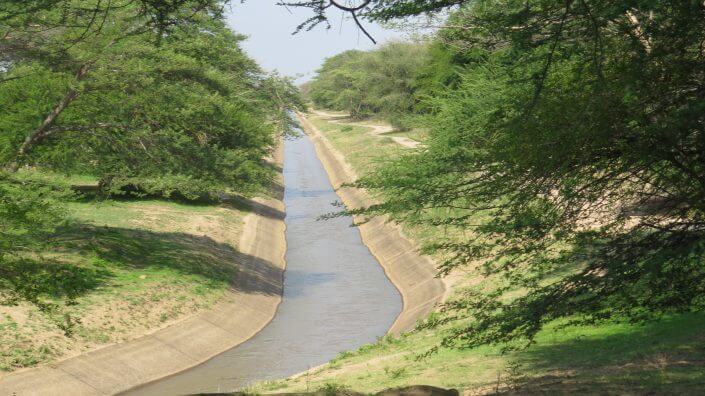Developing an Irrigation Fund in Tanzania
 Agriculture in Tanzania consumes over 90 percent of water with most of it using inefficient gravity open canal and flooding or basin technologies. These methods lead to up to 45 percent water losses. This is despite the fact that critical parts of Tanzania and the Pangani River Basin, in particular, are considered “water-stressed” regions having 1,200 cubic meters per capita of renewable internal fresh water, compared to 1,608 cubic meters for Tanzania as a whole by 2015 (WB, Tanzania Economic Update 2017).
Agriculture in Tanzania consumes over 90 percent of water with most of it using inefficient gravity open canal and flooding or basin technologies. These methods lead to up to 45 percent water losses. This is despite the fact that critical parts of Tanzania and the Pangani River Basin, in particular, are considered “water-stressed” regions having 1,200 cubic meters per capita of renewable internal fresh water, compared to 1,608 cubic meters for Tanzania as a whole by 2015 (WB, Tanzania Economic Update 2017).
Although most of the farmers use buckets and watering cans, over the last few years, the use of 1.5-6.7hp motorized pumps combined with flood or basin irrigation has been on the rise. Though easy to install and cheapest among available technologies (compared to solar, electricity and wind), these pumps have high maintenance costs and short lifespan. At the same time, the open canal systems have the lowest efficiency rates of only 15-25 percent compared to 60-80 percent for lined canals and 90 percent for piped systems. The flooding/basin application systems on the other hand, though cheaper, also has low-efficiency rates of 60-70 percent compared to 90 percent for drip and 80 percent for sprinkler systems.
In 2018, the 2030 WRG Partnership in Tanzania plans to leverage funding from Rikolto (formerly VECO East Africa) to conduct focused assessments, carry out pilots and eventually develop viable financial products for water efficient irrigation technologies required by semi-commercial, commercial smallholder farmers and medium-sized farmers in Kikuletwa Catchment in Kilimanjaro region. This initiative aims to inform an ongoing design of a National Irrigation Financing Facility targeting to improve water use efficiency and agricultural water productivity. The partnership is working in collaboration with Financial Sector Deepening Trust (FSDT), Tanzania Agricultural Development Bank and National Irrigation Commission to name a few.
The planned assessment aims to target smallholder farming groups such as:
(i) Semi–Commercial Smallholder farmers with cultivated land < 2ha
(ii) Commercial Smallholder with cultivated land (10-100 ha)
(iii) Medium sized (Emerging) Farmers with cultivated land (2-10 ha)
During the assessment, 2030WRG expects to develop and test three water efficient technological and financial solutions.
This assessment will focus on nailing down the suggested solutions per farmer profile as well as the expected return on investment. At the same time, a quick scan of the existing financial products will be done. The research findings will also be used in persuading other financial institutions to develop lending products for irrigation financing.
The assessment will analyse the required investments costs and margins of the selected technologies and at the same time determine whether the investment required for the technology is affordable and adds value to the smallholder farmers.,. The end result will be to prove the investment case in order to increase financing by commercial banks or any other financial institutions. The assessment will also assess the existing range of financing options offered by equipment providers, commercial, public and donor lending institutions available in Tanzania and the East Africa region. The research aims to ensure that financing schemes are reviewed for different farmer profiles i.e. large/smallholder farmers, individual, cluster/groups of farmers, different technologies including a diverse portfolio of loans from the farmers’/investors perspective;
Developing technological and financial packages for irrigation financing
There are several companies supplying irrigation equipment, including pumps, pipes, sprinklers, centre pivots, linear move systems, and precision drip and micro-sprinkler systems. However, these companies’ products are suitable for medium-sized farmers and large-scale farmers. The working group aims to design solutions technological and financial solutions for the semi-commercial smallholder farmers and commercial farmers. While doing this, particular focus will be put in ensuring appropriateness of technology in terms of affordability, suitability, accessibility and matching the same with skills of different profiles of farmers.
Market testing and rollout
The stakeholders will select the value chains and a number of smallholder farmers for a pilot of the prototype financial products. During this stage, useful information will be collected and collated to enable improvements to be made on technology and financial products. To buy down some risks, the stakeholders will seek funding for piloting of new financing and technology products. Successful pilots will be commercialized and rollout.
